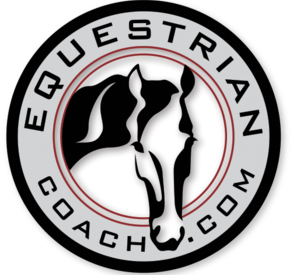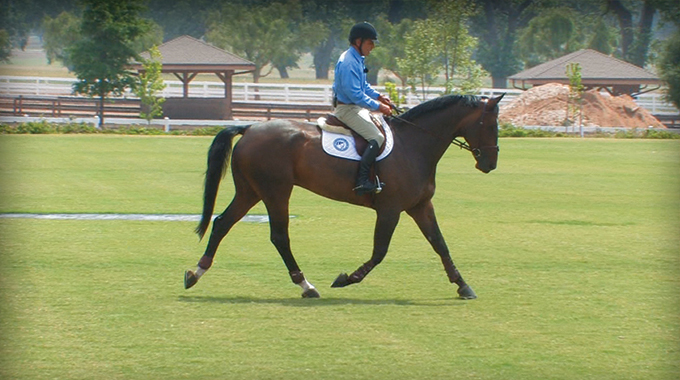Geoff Teall
- 11 Aug, 2016
- 0 Comments
- 6 Mins Read
How to Stop a Horse From Getting Strong Right in Front of the Jump
Panel Experts: Geoff Teall and Linda Allen
Submitted by member: Diana
I have a show hunter mare who is very honest over fences. When I point her at a jump, she nicely takes me there, but at the last minute she runs through my hands and past my distance (her tempo remains the same until that moment). Any suggestions on what I can do to change that? Thank you very much!
Answer by Geoff Teall
I would start to work on this problem with a vertical set as a single jump on a straight line. To begin, I would take out all the fill from this jump, leaving just a set of standards and an “imaginary” jump. I would work my horse through these standards in the walk, trot, and canter. If she showed any inclination at all she was trying change her pace or rhythm, I would quietly stop her on the same line, and even back her a step or two if she was at all strong. Once she was comfortable with this exercise, I would incorporate a rail between the standards where the “imaginary” jump was before. I would do the same thing with the rail on the ground, as far as working back and forth over the rail at the walk, trot, and canter. The beauty of the rail is that if she offers to increase her pace or rhythm over the rail, I am still able to correct her at the exact moment that she offers to get quick. Because this is a rail and not a jump, closing my fingers off the ground does not adversely affect her jump, while at the same time correcting her inclination to get quick.
My next step would be a gradual increase in the number of rails that I incorporate: first a line, then rails off a turn, and even a whole course. As I increase the number of rails the correction for the mare getting quick would remain the same—gently closing my fingers off the ground, and then stopping and backing her on a line after the rail. Once your mare gets the idea of the exercise, you could gradually start to incorporate first lower jumps, and then finally larger jumps into your school. I would continue to always have at least one rail on the ground available to go back to if you need to reinforce having your mare wait.
Answer by Linda Allen
In my experience, it is always tension that makes a horse hurry in front of a jump—some sort of anticipation—of either a surprise or distracting move by the rider, or even of the opportunity to get in a little “play time” after the fence.
To truly jump their best, a horse should be free of even the most well-intentioned interference from the rider during the final couple of strides. They should have 100% of their attention on the fence to assure a well-placed, beautiful round arc, without a casual brush of a toe on a pole. Any adjustments by the rider should be completed before this point, with the horse learning that the final ‘fine tuning’ of either stride or balance is part of his job.
With a sensitive horse and a partnership that knows each other well, even the slightest anticipation of the horse’s quickening by the rider can be felt by the horse, and create a vicious circle of both horse and rider waiting for that subtle cue that will prompt the rush.
If the hurrying on your mare’s part is only slight, consistently practice a patient ride. Resist the urge to ‘help’ by applying extra leg at a slightly longer take-off or resisting with your hands at a deeper spot. This might be all it takes for your mare to catch on that it is on her to make those small corrections, and thus cover up any minor variance in take off spot. A good place to practice this is at home over tiny cavaletti or poles on the ground. Do not try to find a distance to these yourself. Instead, let your horse learn to make the adjustment to stride and balance required to avoid stubbing a toe or being awkward in negotiating them. You will learn to be more passive, and your horse will learn a lot about how to make the exercise easier by paying more attention. Even if your mare and you find this difficult at first, I promise that continuing to practice in a relaxed manner at all three gaits will reap big rewards.
On the other hand, if the hurrying continues to happen at real jumps, or happens farther back than the last stride or two, some re-training is in order. Since the problem stems from tension, punishment or harsh aids are more likely to make the problem worse rather than better. Instead condition for a different response by cantering freely forward toward small jumps at home and doing a quiet transition down to the trot in front of the fence to jump it from a relaxed and slow trot. Make your transition early enough at first that it can be done without strong aids to get it done. Gradually you will be able to do this closer to the fence and eventually be able to maintain a relaxed canter all the way to the fence without your horse feeling the need to hurry at the last moment.
In the case of a fresh horse hurrying in the last stride or two and then continuing to rush and play after a jump, you will need to educate your horse to realize that his job is not finished when he leaves the ground. They still need to be responsive, soft and focused on landing as well. Again, I do not like to create more drama (i.e. tension) with a hard halt after a jump, but prefer to give them a job to do on landing, be that a transition to trot, a soft turn, or perhaps a slightly indirect line to a narrow pole or half a flower box on a shortish stride until they learn that each jump is only a ‘bump in the road’ of the whole course. This is to be accomplished with a calm concentration and even pace throughout.
Good luck and enjoy the process of educating your mare on what it is to be a happy and consistent hunter.
Bernie Traurig wrote a blog post on a similar issue. Click here to view: “Train Your Horse To Stay Calm When Jumping with Flatwork Over Fences”
Video Recommendation:
Flatwork Over Fences
Bernie Traurig
Take a ride with Bernie as he schools “Archie Bunker” and talks you through how he incorporates his flat techniques over small fences. This is an excerpt from the Advanced section of Fundamentals of Flatwork, chapter 14.
Running Time: 6 minutes and 45 seconds
Have Something You Want to Ask Our Panel of Experts?
Ask The Experts is the ultimate way to get help from the top professionals in the equestrian industry without leaving the comfort of your home. This service is available to Monthly, Annual and Lifetime Members of EquestrianCoach.com.


